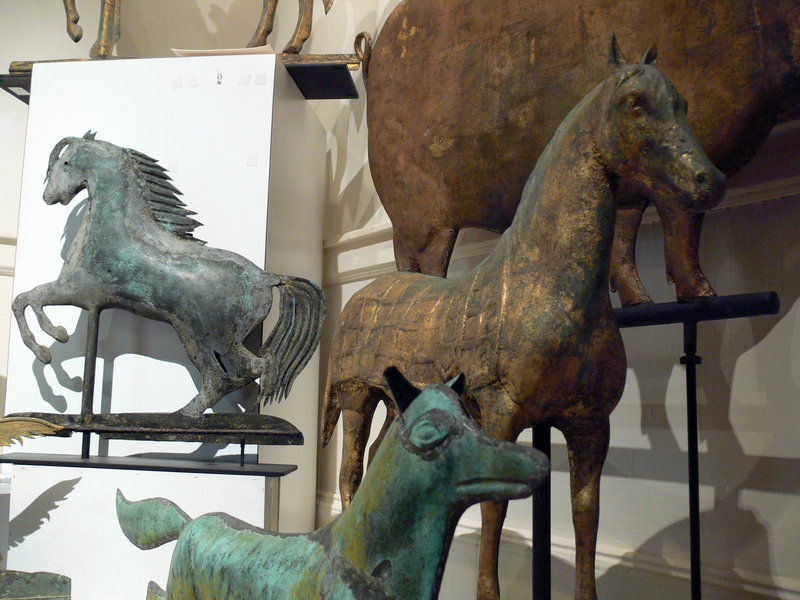You can still find them atop some old barns and other buildings. If there’s an old weather vane on the crest of your building, it’s considered valuable folk art and should be put in safekeeping and replaced with a replica. At least that’s how Julie Lindberg, curator of the Rufus Porter Museum in Bridgton, sees it.
Who knows, that forgotten old weather vane may be just what a certain collector is looking for. It could turn into a new roof or other repair you’ve been meaning to carry out on that old barn.
Featuring weather vanes from New England’s past, “Folk Art On High” is the name of the museum’s current exhibit, which runs until early October.
The museum is on Route 302 in a 1790s Cape-styled home on the northern edge of town. The show features 32 weather vanes, depicting everything from marine life and barnyard animals to patriotic themes.
There’s much more to these items than meets the eye. Many are literally gilded.
Museum staff can convey this rich history. Bridgton had a noteworthy vane maker. James Lombard is known for carving many roosters and hens in the late 19th to early 20th century, the heyday of these weather indicators.
A few of Lombard’s pieces are on exhibit here, including an example owned by the Bridgton Historical Society. The circa-1900 rooster used to sit atop a Bridgton barn; the image is now the historical society’s symbol.
Museum staff said a Lombard vane was recently purchased at auction by a collector; $10,000 is not an uncommon price for a historic vane.
Carved from pine and painted (usually black), Lombard vanes are one of two basic types: wood and metal. Most of the collection displayed at the Porter Museum is metal.
“There’s copper, zinc, iron, and some have lead in them,” explained Bob Boggs, museum education director. “Of course there’s gold and sometimes brass, as well. Typically it’s whatever a metalsmith wanted to work with, or whatever he had at order for.”
The largest vane at the exhibit is a bull attributed to vane maker Cushing & Sons of Waltham, Mass., which was featured in their 1883 catalog. It’s made of copper and covered in gold leaf, measuring nearly 2 feet by 4 feet high. The gold leafing appears as a patchwork of little cubes because gold leaf was typically sold in a book of small squares.
And weather vanes share an affliction with many country road signs: bullet holes. The ones on the bull, and many others at the exhibit, have been repaired. However, a few examples are still pierced with telltale punctures.
Farmers and the general public don’t rely on these weather indicators like they used to. We simply turn to the TV, radio or Internet for an up-to-the- minute forecast.
“But this (weather prediction) was an area of close study for anybody who worked outdoors,” Boggs said. “Farmers prayed for a northwest wind so they could cut their hay and dry it.
“In the spring, a farmer may be wondering if it was a good time to plant – whether or not a storm was coming that might wash away his seed. ‘When should I harvest? Will it frost tonight?’ Wind direction would give them a clue about all of that.”
Boggs explained that before the Civil War, before the nation was industrialized, local woodcarvers and metalsmiths created vanes as a sideline.
After the Civil War, it started to become an industry, with catalogs appearing and weather vanes being shipped by mail order all over the nation and beyond. Some old weather vane catalogs are part of the exhibit and are simply fascinating.
Bringing the display to Bridgton has been in the works for months. It will be returned to Pennsylvania and various private collectors in early October.
“This is one of the best displays you’ll find wherever you go to seek out vanes,” Boggs said.”
Don Perkins is a freelance writer who lives in Raymond. He can be reached at: presswriter@gmail.com
Send questions/comments to the editors.



Comments are no longer available on this story